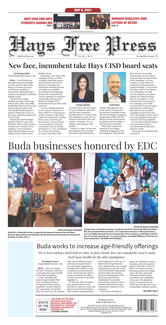By Paige Lambert
During a recent lunchtime rush, the line at Subway on Aquarena Springs Drive in San Marcos never moved, caused by a distracted custommer on his phone. Tashia Anderson, store manager, worried the line would begin shrinking as each frustrated customer left the building.
After that episode, she decided to post a sign: “No cell phones while ordering, please.”
According to a 2014 Pew Research study, 90 percent of American adults own a cell phone. A 2012 study found that 29 percent of cell phone owners described their devices as, “Something they couldn’t imagine living without.”
With cell phones now ubiquitous in American society and integrated into every part of people’s lives, it’s not surprising to see mobile devices disrupting businesses.
Anderson said she would lose customers on multiple occasions because of other customers on their cell phones. Even those distracted by calls would leave.
“One guy actually got mad at us when we asked him to step out of line and finish the call,” Anderson said. “He said we were being rude and walked out without ordering.”
Anderson said it was usually the same people who were always on their phones.
Two weeks ago, Anderson put up the no cell phone sign. Her boss said the sign was fine as long as they eventually put an order in for the person.
Since then, there has been little issue with cell phone use. Regular customers are appreciative and understanding, often hanging up before they get to the line, she said.
Anderson said she thinks the sign will make things better, reminding people that the people behind the counter want their business, not to overhear conversations.
“Are you going to wait when someone walks into your business distracted by a phone, or are you going to help the next customer?” Anderson asked.
The mobile device has not only affected customer-employee relations, but the reverse as well.
Russell Furth, practice manager at Kyle Medical Center, said he had to create a restricted phone-use policy with his staff a few years back.
“It’s actually been a problem in our back office,” Furth said. “Staff on mobile phones slows down the physician-patient scheduling process and angers patients and providers.”
Furth said he can’t completely ban cell phones, because many of his staff have small children and need to be easily reachable. However, the phones are still an issue.
As the percentage of people with phones has grown, more businesses have posted signs and created policy about restricted cell phone use.
Nevertheless, some business owners see the use of signs deterring customers.
“It doesn’t bother me at all, as long as they aren’t loud or cursing,” Margaret Goebler, owner of Little Bluebird in Buda, said.
Goebler said her view might be different if she owned a restaurant instead of the boutique. In her store, people spend most of their time looking around, not interacting with others.
“A customer walking in could be talking with a doctor or a distant relative, and asking them to leave could make them not come back in,” Goebler said. “This way they are more likely to spend more time inside my store.”
If someone is still on the phone when Goebler rings up his or her purchase, she said she continues business as usual.
“I don’t wait for them to finish,” Goebler said. “I just tell them their total, hand them the receipt and go on.”
While the effect of mobile devices in business relations varies, there is no doubt that it will continue to be part of our daily interactions.





